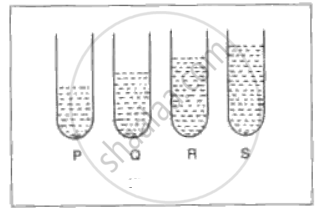Advertisements
Advertisements
प्रश्न
In fig. , P, Q, R and S represent test tubes each of height 20 cm which are filled with water upto heights of 10 cm, 14 cm, 16 cm and 18 cm respectively. If a vibrating tuning fork is placed over the mouth of test tube Q, a loud sound is heard.
(i) Describe the observations with the tubes P, R and S.
(ii) Give the reason for your observation in each case.
(iii) State the principle illustrated by the above experiment.

उत्तर
(i) No loud sound is heard with P and R but a loud sound is heard with S.
(ii) Resonance occurs with the air column in tubes Q and S whereas no resonance occurs in the air columns of tubes P and R. The frequency of vibrations of air column in the tube S is thrice the frequency of vibrations of air column in the tube Q, while the frequency of vibrations of air column in tubes P and R is neither equal to nor an integer multiple of frequency of vibrations of air column in tube Q.
(iii) When the frequency of vibrations of air column is either equal to or an integer multiple of the frequency of the vibrating tuning fork, resonance occurs.
APPEARS IN
संबंधित प्रश्न
Differentiate between the forced and resonant vibrations.
How do you tune your radio set to a particular station ? Name the phenomenon involved in doing so and define it.
Name the phenomenon involved in tuning your radio set to a particular station and define it.
(i) Define resonant vibrations.
(ii) Which characteristic of sound, makes it possible to recognize a person by his voice without seeing him?
Differentiate between the following:
Light and sound waves.
On keeping the stem of a vibrating tuning fork on the surface of a table, a loud sound is heard. Give reason.
State two ways in which resonance differs from forced vibrations.
A string stretched between its ends is made to vibrate by placing the stem of a vibrating tuning fork at its one end. State three ways how you will increase the frequency of note produced by the string.
